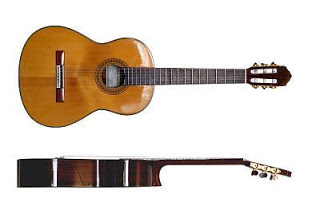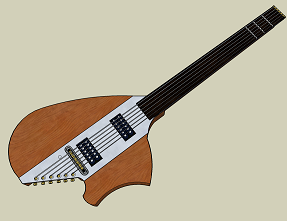Guitar
The classical Guitar
Back in the old days, before we had electric guitars, a guitar looked like this:

CC Martin Möller, Creative Commons Attribution ShareAlike 2.0 Germany, resized by me
It's beautiful and sounds nice, but it's not particularly easy to play.
There probably exists a number of very good reasons for this unhandy shape and size. Being totally acoustic, the guitar needed to have a large body. The tuners had to be at the end of the neck, as mounting them on the thin and acustically crucial soundboard would probably have been out of the question. Why the body had to have the shape of a rather large figure eight is beyond me. It probably has to do with acoustics, too. Alternatively, the reason mighe be that it makes it easier to rest the guitar on your thigh - and for symmetry reasons, the other half was shaped accordingly.
When technologies evolve, they often retain some of the drawbacks of earlier versions. Probably because many designers (and customers) are quite conservative and don't like things to depart too much from what already exists. Early automobiles, for example, resembled horse carriages to an unnecessary degree.
The Electric Guitar
I think the same effect is in play for the electric solidbody guitar. At least when looking at the most well-known brands and models such as Fender, Gibson and PRS. It still has a head at the end of the neck, even though it tends to make the guitar neck heavy and always hits other objects and people when you move the guitar around. It still has a rather large and thick body, though acoustics do not come into play any longer. It still has the shape of a fat figure eight, albeit with cutouts at one or both sides for easier access to the higher frets.
To me, the bottom cavity of the figure eight is in the wrong position: If i have it on my right thigh, it feels too much to the right and vice versa. A cavity located nearer the bridge would be more suitable, as resting the guitar on the right thigh would give a usable position. At least, so I think. Regarding the other inherited features from the classical guitar, I'd like a thin guitar allowing my playing action to be close to the body, a compact guitar with no head for knocking out the teeth of other band members, a light guitar that don't break my back.
The Ergonomic Guitar
Hence, one of the early decisions in the desigh of the T-beam prototype was to go for a headless and ergonomic design. On Building the Ergonomic Guitar, there is a lot of discussion on suitable shapes and design principles, plus articles on some of the smaller luthiers, who build ergonomic guitars. Especially the Klein guitar shape caught my attention: It simply looked like it would be easy and relaxing to play.

My design will be something like this. The exact shape of the wings may vary. I might experiment with several shapes and woods for the wings. But overall, this is what it will look like. I don't try to make it look like any particular one among the existing ergonomic guitars, but I think the Forshage electric guitar is the one it's going to resemble the most. The Forshage, in turn, is inspired by the Klein, BTW.
The picture of the ergonomic T-beam guitar is an older (i.e. around two months) design. I later abandoned having the traditional tuners at the bottom of the guitar in favour of a different desing, instead using a bridge with integrated fine tuners. More about these considerations in a later post.
- Budget Ergonomic Guitar Is A Klein/telecaster Hybrid
guitarz.blogspot.com: Ergonomic guitars don't usually come very cheap. They are specialist instruments and are very often luthier built. It's little wonder that many people have sought to build their own, which is where the resources available...
- More Sketches
I was thinking that I could explain a little bit to the new readers of this blog what I'm trying to do here… This morning as I was making these sketches (sitting in the sun at the terrace of a cool Viennese café), I realized that the D model...
- Setting My Sights A Little Lower
It can't have escaped anyone's attention that I haven't yet built the T-beam guitar. Even though I've talked a lot about it, nothing tangible has emerged. I've bought the components and there's nothing much missing. It's just...
- Alternatives To The T-beam
I've tried quite a lot of places to get the crucial component, the T-beam. It is more difficult than I originally expected. I've tried a couple of scrap metal dealers and the leading Danish metal distributor. Plus a couple of web-based stores....
- Background - Why And How
Over the last years, I've become more and more interested in building guitars rather than (just) playing them. I never got around to actually building anything, but I took a couple of guitars apart and put them together again. I also discovered, that...
Guitar
Guitar Ergonomics
The classical Guitar
Back in the old days, before we had electric guitars, a guitar looked like this:
CC Martin Möller, Creative Commons Attribution ShareAlike 2.0 Germany, resized by me
It's beautiful and sounds nice, but it's not particularly easy to play.
There probably exists a number of very good reasons for this unhandy shape and size. Being totally acoustic, the guitar needed to have a large body. The tuners had to be at the end of the neck, as mounting them on the thin and acustically crucial soundboard would probably have been out of the question. Why the body had to have the shape of a rather large figure eight is beyond me. It probably has to do with acoustics, too. Alternatively, the reason mighe be that it makes it easier to rest the guitar on your thigh - and for symmetry reasons, the other half was shaped accordingly.
When technologies evolve, they often retain some of the drawbacks of earlier versions. Probably because many designers (and customers) are quite conservative and don't like things to depart too much from what already exists. Early automobiles, for example, resembled horse carriages to an unnecessary degree.
The Electric Guitar
I think the same effect is in play for the electric solidbody guitar. At least when looking at the most well-known brands and models such as Fender, Gibson and PRS. It still has a head at the end of the neck, even though it tends to make the guitar neck heavy and always hits other objects and people when you move the guitar around. It still has a rather large and thick body, though acoustics do not come into play any longer. It still has the shape of a fat figure eight, albeit with cutouts at one or both sides for easier access to the higher frets.
To me, the bottom cavity of the figure eight is in the wrong position: If i have it on my right thigh, it feels too much to the right and vice versa. A cavity located nearer the bridge would be more suitable, as resting the guitar on the right thigh would give a usable position. At least, so I think. Regarding the other inherited features from the classical guitar, I'd like a thin guitar allowing my playing action to be close to the body, a compact guitar with no head for knocking out the teeth of other band members, a light guitar that don't break my back.
The Ergonomic Guitar
Hence, one of the early decisions in the desigh of the T-beam prototype was to go for a headless and ergonomic design. On Building the Ergonomic Guitar, there is a lot of discussion on suitable shapes and design principles, plus articles on some of the smaller luthiers, who build ergonomic guitars. Especially the Klein guitar shape caught my attention: It simply looked like it would be easy and relaxing to play.
My design will be something like this. The exact shape of the wings may vary. I might experiment with several shapes and woods for the wings. But overall, this is what it will look like. I don't try to make it look like any particular one among the existing ergonomic guitars, but I think the Forshage electric guitar is the one it's going to resemble the most. The Forshage, in turn, is inspired by the Klein, BTW.
The picture of the ergonomic T-beam guitar is an older (i.e. around two months) design. I later abandoned having the traditional tuners at the bottom of the guitar in favour of a different desing, instead using a bridge with integrated fine tuners. More about these considerations in a later post.
- Budget Ergonomic Guitar Is A Klein/telecaster Hybrid
guitarz.blogspot.com: Ergonomic guitars don't usually come very cheap. They are specialist instruments and are very often luthier built. It's little wonder that many people have sought to build their own, which is where the resources available...
- More Sketches
I was thinking that I could explain a little bit to the new readers of this blog what I'm trying to do here… This morning as I was making these sketches (sitting in the sun at the terrace of a cool Viennese café), I realized that the D model...
- Setting My Sights A Little Lower
It can't have escaped anyone's attention that I haven't yet built the T-beam guitar. Even though I've talked a lot about it, nothing tangible has emerged. I've bought the components and there's nothing much missing. It's just...
- Alternatives To The T-beam
I've tried quite a lot of places to get the crucial component, the T-beam. It is more difficult than I originally expected. I've tried a couple of scrap metal dealers and the leading Danish metal distributor. Plus a couple of web-based stores....
- Background - Why And How
Over the last years, I've become more and more interested in building guitars rather than (just) playing them. I never got around to actually building anything, but I took a couple of guitars apart and put them together again. I also discovered, that...
